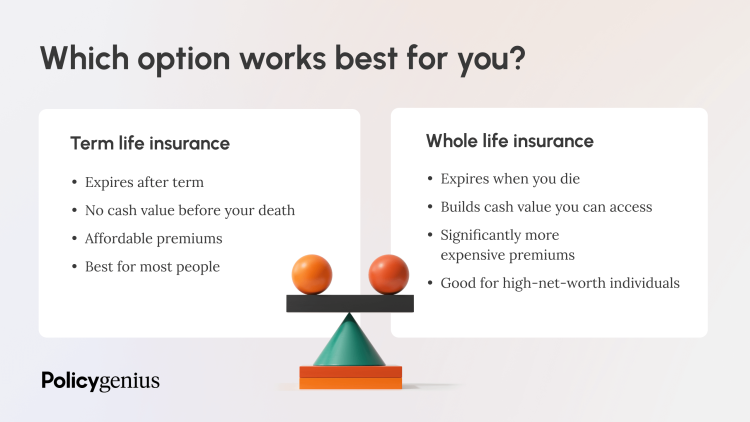Out of all the individual life insurance policies purchased in 2021, 40%, or 4.1 million, were term insurance, an affordable form of life insurance that only lasts for a set period of time. The other 60% of individual life insurance policies purchased in 2021 were permanent life insurance policies, which provide coverage for life and can accumulate cash value, but cost more than a term life insurance policy. Permanent life insurance policies can come in many forms, including universal life, variable life, and variable-universal life, but whole life insurance, which has consistent premiums and can accumulate cash value, is the most popular.
Financial advisers say most people should buy term life insurance. It’s simple and affordable and you’re better off just spending less on life insurance and investing the money you save in the stock market.
“Over the long term, you make more money in the stock market with a diversified portfolio,” says Angela Dorsey, a certified financial planner and founder of Dorsey Wealth Management.
Still, the numbers don’t lie: More people buy permanent life insurance. Here are three reasons so many people opt for permanent life insurance.
1. People want insurance for life
Financial planners view life insurance as a short-term need, says Randy Dumm, director of the Baldwin Risk Partners School of Risk Management and Insurance at the University of South Florida. As you get older, other people become less dependent on your income, so your need for life insurance goes down. For example, you might buy life insurance in your 30s, when your income helps feed your young children and pay your mortgage. By the time you’re 60, those kids are grown and the mortgage is paid off, so there’s less of a need to insure your income.
“It’s viewed as a shorter-term solution by the financial planner,” Dumm says.
On the other hand, many people like the peace of mind of knowing that their whole life policy will cover them no matter when they die.
“Extremely security-conscious people still gravitate toward whole life insurance,” Dorsey says. “This is because of the certainty and predictability whole life insurance offers.”
2. Whole life insurance provides guaranteed returns
Because term life insurance is affordable (a healthy 30-year-old can expect to spend $30 a month or less for a policy with a 20-year term and $500,000 death benefit), planners often recommend a strategy of buying term and investing the savings in the stock market for maximum returns. They don’t see whole life insurance as the best way to earn big returns, Dumm says.
On the other hand, stocks can lose money, so more risk-averse investors may prefer the cash value component of whole life insurance, which guarantees returns to an extent.
“Knowing that they will have guaranteed cash value growth that is not subject to the ups and downs of the stock market gives them peace of mind,” Dorsey says. “Security-conscious people feel more anxiety with the short-term market volatility and are willing to pay extra to help them sleep at night.”
In general, people who opt for whole life insurance are willing to pay more for less risk.

3. ‘Life insurance is sold, not bought’
Life insurance isn’t something people are motivated to run out and buy on a whim, like pizza. Often, people get interested in life insurance when life insurance agents reach out to them. And selling whole life insurance is more lucrative for agents than selling term life insurance.
“There is an incentive difference you have to recognize,” Dumm says.
That’s why you see TikTok influencers hawking whole life insurance as a way of “infinite banking” — alluding to the way you can borrow against the policy’s cash value. They don’t tell you it’s not an effective strategy for most people, and these videos still garner millions of views.
Even though there are plenty of ways for people to learn about life insurance and other financial products on their own online, people still like talking to other humans about these decisions.
“We’ll see where consumer preferences go,” Dumm says. “Right now you can get a lot of information via the web, and they can buy some products via the web, but there still seems to be a preference by consumers to have this human interaction.”
Image: Ippei Naoi / Getty


